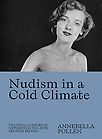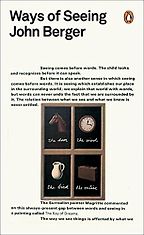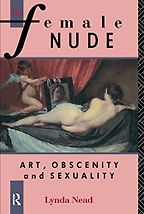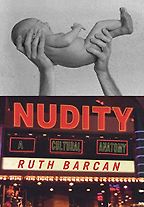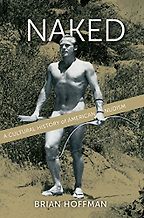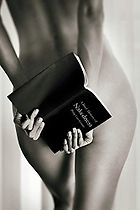Before we launch into your chosen books, what is the nude?
Well, it depends whether you’re talking about the nude in art or whether you’re talking about the nude body in everyday social life, on a personal level. Then again perhaps you’re talking about nudism, or naturism as it’s sometimes called, as a form of social organisation. Part of what I’ve been interested in is the overlap, the different cultural meanings around those different concepts and practices. Nudism as a social movement would see itself as being very, very separate to the representation of the idealised nude body in an art gallery, for example.
One of the things that I’ve been interested in exploring is how nudists historically have visually represented their movement. Often they’ve drawn on the canon of artistic styles and poses from art history to give legitimation to what they do, and to promote an ideal public image. Because the nude, historically, at least until about the late 20th century, was a practice of idealised artistic representation, often with female bodies at the centre. So often when people talk about the nude, and they’re thinking about the nude in art, they’re actually thinking about the female nude, and quite an idealised female nude at that.
That’s obviously very different to the reality of bodies without clothes. The canon of Western art is a historic system of visual representation that has established nude norms. Although there are notable exceptions, it can exclude male bodies, older bodies, larger bodies, bodies of all different skin colours, bodies of all different abilities…
I think the term nude is quite mobile. And nudity is not the same as the nude. Nor is nudity the same as nudism, but they tend to overlap quite a lot in people’s minds. One of the authors that I’m going to discuss says that nudity is the world’s greatest metaphor. It’s used as a means to discuss all sorts of messages and carries a whole range of meanings. These meanings however differ over time, and they differ according to place.
Let’s speak about the first book in your selection. John Berger’s Ways of Seeing is a landmark text that we’ve featured on the site previously. Here’s a book that really upended traditional readings of art history, and perhaps nowhere more so than in his discussion of the nude female form.
I use Berger’s book as a piece of primary research towards the end of my own book to show how, when Berger published his art history in the 1970s, traditional attitudes were starting to break down around the representation of the nude body. Meanings around the nude in art history had been upheld and rarely subject to much criticism, in fact, until his book appeared. That’s when traditional interpretations started to fall apart.
Get the weekly Five Books newsletter
The book is structurally quite innovative. Not only do I appreciate his arguments, but I really liked what he does in the way that he puts it all together. Ways of Seeing has certain pages with very little text, sometimes no text at all, where Berger puts images from high art, Renaissance painting for example, in juxtaposition with soft porn magazine advertising from the early 1970s. He shows very clearly how the two examples are drawing on a shared language. That was revolutionary at the time, though interestingly, although that’s 50 years ago, it remains really relevant. Parts of the book may now feel dated and have been superseded by more recent criticism, but I still recommend it in my teaching as an entry level text for new students coming to the study of visual culture for the first time who haven’t really thought about it before. It’s still a really interesting little tome, and about much more than the nude of course. I like what he does by dismantling established hierarchies.
Several lines in the book make the distinction between nakedness and nudity very clear. He says, for example, “To be naked, is to be oneself. To be nude is to be seen naked by others, and yet not recognised for oneself”. Or in another passage, “Nakedness is nature; nudity, culture”. There’s a clear distinction between a natural state and let’s say, a civilised or an unnatural state.
His ability to form a pithy statement, whether or not we agree with that pithy statement, is one of the charms of the book. Berger gives you these provocations. One that I really liked is where he says, “nudity is a form of dress”. That really interested me because, in part of the teaching and research that I do, I cover histories of photography as well as histories of fashion. It seems to me that you can’t really discuss nudism without discussing clothes – clothes are the enemy! Clothes are the antithesis. So you have to look at these two things in relation to one another. I find that quite an exciting provocation. Undress is as important as dress.
This relates to Lynda Nead’s book. She looks at the representation of the female body in the Western art canon and what the framing of the nude body in culture tells us about the society of the day.
Although this was published some years ago, The Female Nude: Art, Obscenity and Sexuality is undimmed by the passage of time. She looks at how we frame the nude, and more specifically about the boundaries between what is and what is not considered nude. These border definitions in her case involve thinking about art and obscenity, or more subtly, thinking about pornography versus erotica. She also considers what these boundaries mean for who’s doing the looking and who’s doing the presenting. She’s a pioneering feminist art historian, whose work subsequent studies build upon. I have certainly absorbed its lessons.
“ The term nude is quite mobile. And nudity is not the same as the nude. Nor is nudity the same as nudism, but they tend to overlap quite a lot in people’s minds.”
I find it endlessly provocative. Thinking through categories, which move around depending on who’s looking and who’s valuing, is a challenging feat, when every set of cultural contexts is really fluid. Her writing about the life model I found particularly thought-provoking, looking at the (typically) male artist and the (typically) female model in relation to one another. On a personal level, this was fascinating to me. I was glad to work as a life model throughout my late teens and early 20s, in the 1990s, although it was impossible to ignore that it was almost always young women who were modelling and almost always older men who were drawing and painting in those classes. Lynda Nead scrutinises this tradition as part of her study. In my work I’ve tried to involve that perspective. I want to always think about the motivations of the models who are depicted in representations of the nude and where possible, try and name them and credit them because often, they’re not known.
In looking at the boundaries between art and obscenity, or erotica versus pornography, she considers the ways these boundaries are legislated for. There is a legal structure involved in the regulation of the body, in either its cultural representation, or its sexual representation.
This is an extremely difficult task because pornography and obscenity are really in the eye of the beholder. Witness how attitudes to nudity have changed over time, and how they continue to change. From a legal standpoint, these concepts are incredibly hard to pin down. Part of what I was researching in relation to nudism throughout the twentieth century was the legal context. Legislation really came to the fore in the 1960s, when there were a lot of high-profile conflicts and now famous legal battles relating to obscenity that really tested legislation that had been in place in Britain since the mid-1800s. By the 1960s, these laws were hopelessly outdated, and yet there was still an effort to enforce them.
The court proceedings around Lady Chatterley’s Lover are known as a pivotal cultural moment in the 1960s. But it was far from straightforward, even by the standards of the day. The representation of the nude body in different contexts, whether it was in photographs or films designed for ‘masturbatory aid’, shall we say, or whether it was something that was intended to be art, all of that came under scrutiny. It was fascinating to revisit the work of specific photographers and the court cases they were involved in. The arguing to and fro is absolutely preposterous at times, certainly by the standards of our own day. But what’s more, the litigants often can’t even say what it is they’re arguing about! It becomes like a soapbox shouting match with a lot of sparring and shadowboxing going on, where the subject is discussed quite obliquely, if at all, because many of the offending images are unmentionable in polite society at the time, so they’re intimated rather than referred to explicitly.
“Witness how attitudes to nudity have changed over time, and how they continue to change. From a legal standpoint, these concepts are incredibly hard to pin down”
It can seem quite ridiculous. For example, in my discussion of the British nudist movement of the mid-twentieth century, I point out how genitals and even pubic hair could not be displayed in naturist publications from the 1920s to the early 1970s. In fact, they could barely be show in any publications at all, whether it was a work of anthropology, or a work of titillating glamour photography or an art publication. One simply could not show pubic hair without risking prosecution, and so models had to be posed in elaborate ways, and photographs cropped in ways that the completely avoided that area of the anatomy. Models either had to turn their back to the camera – buttocks were okay – or the image would require editing. Frontal nudity was not okay if it showed genitals or pubic hair. What we find as a result is a range of avoidance strategies, including scraping out the offending area, or retouching the negative, to remove any evidence of pubic hair, leaving behind a strange empty space, much more conspicuous than the original depiction. Much of the debate around nudity at the time became about pubic hair itself, whether to show it or not, all of which now seems remarkably bizarre, and also historically distinct given what pubic hair is taken to mean in the 21st century, and new practices – and controversies – about shaving. These strange empty spaces of the era were worse than showing the hair itself, because they created a vacuum which of course was then flooded with interpretation.
Censorial policies like these created an idea of forbidden fruit, which is exactly what the nudist movement was trying to avoid. Nudism was meant to be changing cultural ideas about shame, and changing cultural ideas about parts of the body being sexual. Nudists in Britain – then and now – wanted public or social nudity to be non-sexual.
Nudity as one’s natural state is something that Ruth Barcan’s book, Nudity: A Cultural Anatomy takes as a central premise. Her book is full of fascinating case studies that illustrate our contradictory attitudes to the naked body. She talks with strippers, pornographers, morticians, nurses, tattoo artists, and of course, nudists as well. But her argument takes a really philosophical turn. Nudity in her view is the central metaphor of the Judeo-Christian Western tradition. It’s a metaphor for human nature itself.
That’s what makes her work so rich. It is the breadth of what she does with the topic. She thinks so far beyond the nude on the gallery wall. She’s thinking about it through the history of philosophy, in relation to the history of religion. She thinks about it as well in all sorts of pop culture forms – advertising, entertainment, media. she can be quite playful, but she’s also a very impressive scholar. Every time I refer to this book, I find something new in it.
She traces dualisms of many kinds: nature versus culture, civilised versus savage, chaste versus unholy. These are the kinds of conceptual structures around which moral values play out, and they are absolutely essential to understanding what nudity means to us. I really like the fact that her cover image of her book is of an unclothed baby, this idea that you’re born into this natural state of liberty, which then becomes culturally marked depending on where you’re born, when you’re born, and the culture into which you’re born.
“Much of the discourse of naturism involves references to Eden, a lot of talk about Paradise and returning to something that’s been lost”
Barcan shows the many contradictions in our historic and contemporary understandings, but also the kind of duality in the very concept of nudity, in the Christian or even previously in the Greek tradition. Nudity could be viewed as a symbol of purity, or simplicity, a kind of an original state, Alternatively, it could be seen as degradation or exposure.
You see this in one of the foundational myths of Christianity, the story of Adam and Eve cast out of the Garden of Eden and becoming aware of their nakedness. That’s very closely tied to the idea of original sin. It’s a duality that seems to make our culture uneasy still, even in the 21st century.
Social media only amplifies the dilemma. When bodies are viewed by machines on a massive scale, you get new contradictions coming through in very particular ways, sometimes quite draconian ways. The likes of Facebook and Instagram have blanket bans on nudity, so even nude bodies that might be considered benign or even positive get excluded. These categories are so subtle and open to interpretation that even law courts, philosophers and religious scholars have difficulty defining them. It’s very hard to handle on the large scale of the web, in some sort of black and white, cut and dried way.
The Western canon of visual art has effectively been blacklisted by Facebook and Instagram. I wonder what John Berger would make of that! Or the Louvre and Uffizi suing Pornhub for turning works by Titian and Courbet into hardcore pornography….
Viennese art galleries actually created their own social network channel on OnlyFans because they found themselves unable to show images from their collections on mainstream social media. I think they partly did it to create a provocation and to show the illogicality of social media approaches, but the simple fact that they’ve taken out a channel on what is largely known as a porn site, typically reserved for camgirls and other sexual performers, gives an idea of the extent of the censorship of painting and sculpture on social media.
Let’s move on to talking about naturalism or nudism as a social movement. I guess the name says it all – naturalism suggests a natural state. Philip Carr-Gomm’s book A Brief History of Nakedness is replete with examples of natural and very unnatural ways of being naked.
Naturists is what practitioners like to call themselves in Britain, as distinct from naturalists, which might be confused with more scientific pursuits like being a botanist or conservationist. Naturism was a term that was bought in slowly, at least in Britain, but it was adopted wholeheartedly in the mid-1960s. Then it became the formal name to designate the movement, although it was used interchangeably with nudism up to that point. Nudism, obviously, because of these category issues we’ve discussed, could be used to suggest associations that naturists found negative, such as nude dancing or performance on stage or sexually charged imagery more generally. Naturists wanted to separate themselves off from that. Many ideas about a kind of perfect state of nature that we mentioned earlier run through naturism.
Much of the discourse of naturism involves references to Eden, a lot of talk about Paradise and returning to something that’s been lost. Partly, this reflects a sort of disenchantment with the modern world. It is a movement that suggests you might be able to return to an original state of grace, one that was once pure and original, but which had been sullied by new cultural messages and meaning. That’s one of the underpinning principles of naturism.
“Censorial policies like these created an idea of forbidden fruit, which is exactly what the nudist movement was trying to avoid”
Now, Carr-Gomm is an interesting person, and his is quite an idiosyncratic book. I chose it because 300 pages of dense academic scholarship on nudity and culture is not everyone’s cup of tea. Many of these books I discuss take commitment to read and they address academics. A Brief History of Nakedness takes some of the same principles as its starting point, but aiming at a more general readership, and bringing some of those ideas right up to the present day including, for example, naked bungee jumping and other cultural phenomena that may seem rather flippant and silly. It’s a worthwhile read a few reasons.
The author is a Druid. For a time he was the leader of an order of Druids in Britain, and he’s quite well-known in the pagan community for his publications about practical magic. The fact that he would write this book is really interesting to me. As you might expect, he does have a particular angle where considers the spiritual meanings of nudity, but actually, that’s not the bit that I find most interesting. The parts I find most interesting are particularly the examples he gives of how nudity always attracts public attention. It has been utilised for advertising in a range of different ways, and this is well documented in the book, but also for public spectacle and for protests. Many nudists, and lots of nude practices of different types, have been challenging the law. Take nude hiking, for example, as a famous case in Britain where protesters would set off in hiking boots, a rucksack and nothing else to argue for ramblers’ rights of way, as well as the illogicality of not being able to appear naked in public.
Which brings to mind peace protests like ‘Breasts Not Bombs’, women exposing their their breasts or indeed their entire bodies as a way to draw sensationalist attention to a cause.
It’s really interesting, but also fraught with complications. It goes back to Lynda Nead’s feminist study where she argues there is a fundamental challenge in feminist artists using the nude body as their medium – you can end up producing works that have a feminist intention where the outcome nonetheless involves the naked body, again, that could be read by audiences in multiple different ways. And yet, feminist groups which use the naked body in protest against objectification and sexualization are obviously creating the conditions of consent themselves. They are choosing to appear in a very self-determined way. The outcome is still naked female bodies in public, however, so it’s full of challenges.
Interestingly, Carr-Gomm lives just down the road from me! I don’t know why there’s such a density of scholars on this subject in one particular area. We both live near Brighton on the south coast of England, a place where the first ever nudist beach was instituted in this country by a local council in the 1970s. We also host the famous Naked Bike Ride, and there is also a massive annual Brighton Gay Pride parade. In this neighbourhood there is a culture of the body being used in a range of different and sometimes quite challenging ways.
It’s intriguing that organised nakedness never really became a mass movement in Britain, or the United States, in the way that it did in parts of continental Europe in the first half of the 20th century. Your final selection, Naked: A Cultural History of American Nudism by Brian Hoffman, links very closely with your work, and poses the question. Why is it that Anglo-Saxons have, in Western culture at least, seemingly a unique reticence about the naked body compared to their continental peers?
Germany was in many ways the heart of modern nudist culture in the modern world. Ideas that first developed in the late 19th and turn of the 20th century, turned away from urbanism, seeking a more authentic state of being. Nudism rejected ideas about cultural sophistication in favour of something that seemed to be much more earthy. It was connected in Germany with the emerging youth movement as well. This very particular German character, when it traveled overseas, was taken up in different ways in different places.
Brian Hoffman studies how that idea transferred to America and how it became a particularly American kind of practice. I’ve done the same for Britain, where nudism also emerged in different ways with different characteristics and attitudes, taking on a form which is quite nationalistic. Interestingly, even though nudity appears as universal, as this thing that unites all humanity, all of us embodied creatures, when it starts to become rooted in social practices, when club cultures emerge or when local literature starts to emerge by certain authors, nudism develops a very particular flavour.
“That there is a kind of non-civilised world that the civilised world can learn from is a key tenet in early 20th-century nudism”
Hoffman’s interest is to show how nudism developed in North America from from the 1920s onwards. Interestingly, he’s a scholar of American nudism but he also grew up in a nudist family in California, in what he describes as a ‘clothing optional community’. Moreover, his father was a lawyer and his mother a nurse. This is a really interesting pairing, for the ways that law and health intertwine as two drivers for the central discussion points that underpin nudism. As a result, he’s got this range of really interesting perspectives.
Five Books interviews are expensive to produce. If you're enjoying this interview, please support us by donating a small amount.
He looks deeply at the archival sources, and conflicts with law, for example, which are different in America and Britain, as my own archival work shows. Other aspects of the movement are also quite distinct to America, where nudist culture comes with a whole range of accoutrements and trappings and rather well kitted-out sites. As well as a very particular attitude to ethnicity and race. As an outgrowth of European culture of the late 19th century and early 20th century, nudism as a social form was originally very white. When it moves to different locations, its cultures and communities change, and this is particularly challenging in mid-century America, where nudism’s whiteness was subject to great scrutiny because of greater consciousness about race relations, the civil rights movements, and so on. Ideas about black, brown and tanned as opposed to white-skinned bodies play out in particular and interesting ways.
Historically, there’s a dichotomy between the clothed versus the primitive, the naked savage, with imperialist-colonial and racist overtones that we find repercussions of throughout the 20th century.
Studying nudism in Britain, we see these attitudes shifting over time. Britain in the early days of nudism in the 1920s and 1930s was almost completely white. This was in part a result of demography as there were fewer than 10,000 black people in Britain around that time. From 1948 there was a big shift in immigration, and ever more discussion among nudists about the meaning of tanned, black and brown skin. Connected to that debate is the idea I mentioned earlier about returning to paradise, or a Garden of Eden fantasy, where it was debated whether so-called ‘civilised’, urbanised white people could learn from so-called natives, ‘primitive savages’ and other terminology that we would absolutely not use now. British nudists considered some non-industrialised and small-scale societies to have a closer relationship to nature.
Get the weekly Five Books newsletter
There was a pronounced health aspect to much of this language. Non-industrialised nations were perceived to be less troubled by digestion problems, constipation, pain in childbirth – and all sorts of claims are made for a very homogenised ‘noble savage’ type fantasy. There are figures in the British nudist movement of the early 20th century who were former colonial administrators, or were employed outside Europe on military services postings. They had lived elsewhere in the world and seen first hand other cultures living with different relationships to their bodies, having different relationships to clothes. Returning to Britain, many of them wanted to encourage others to learn from this experience, arguing that the British have this very stuffy, shameful culture around the body, that we are very overdressed, overly formalised. So often, however, these attitudes were couched in ignorance. Even when they were admiring, they were quite patronising. Nonetheless, the idea that there is a kind of non-civilised world that the civilised world can learn from is a key tenet in early 20th-century nudism.
We’re moving into a cultural moment where ever more of our personalities, our identities, are finding digital representation. What do you think happens to the nude in the Metaverse?
I don’t have a definitive answer, but I think in the Metaverse, the Silicon Valley driven social media world, public nudity will have no place. The likes of Facebook or Meta won’t be able to handle nudity because it’s too nuanced. It’s hard to manage. These books show just how hard!
Incidentally the front cover ‘dust jacket’ flap on your own book was an inspired choice for its combination of titillation and self-restraint!
Well, you can’t sell a book on Amazon that has full nudity on the cover, even if it’s about the nude! We had to find a creative solution. The other thing is that nude cultures are always bordering pornographic cultures, even if they don’t have that as their intention. The ability for nude representation to be co-opted as a form of sexual stimulation is always there, a constant threat. Once borders were broken down in the late 1960s and once visual culture became more accepting of the highly sexualised body, when pornography became more palatable, or at least more public, things really started to break down with many of the traditional boundaries we inherited historically. This co-opting is of course ever greater now, because the places where pornographic material can be consumed have expanded massively. As a result, I think they still remain a threat for people who want to gather nude together, and not to be objectified and sexualised.
“Naked yoga via Zoom was booming during lockdown!”
Naturists themselves see an opportunity in building their community in online spaces. But a lot of the real practice still happens in the flesh. It’s still about gathering together. During lockdown, the naturists who I’ve been in touch with and who’ve given me access to their collections of archival material, couldn’t congregate in this country. We had very strict quarantine rules. You couldn’t gather for long periods of time in 2020 and 2021, and with social distancing, restrictions to travel and the temporary closure of nudist clubs, it was very difficult. But naturists have expanded their presence online and they now gather in Zoom meetings. Naked yoga via Zoom was booming during lockdown!
I’m not convinced that it’s completely satisfying. I think the real life practice of people of all shapes and sizes meeting together in the flesh without clothes is fundamental to the movement. It’s hard to see that being replicated in a very mediated way, at a distance.
Five Books aims to keep its book recommendations and interviews up to date. If you are the interviewee and would like to update your choice of books (or even just what you say about them) please email us at [email protected]

